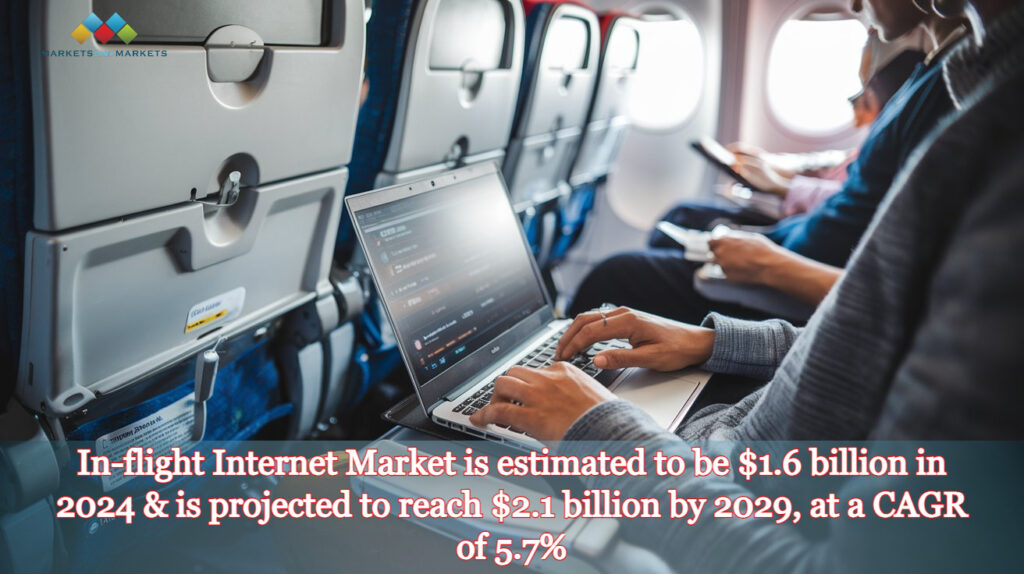North America, particularly the United States, is poised to lead the growth of the in-flight internet market, driven by the region’s high air travel volume and the increasing demand for reliable connectivity among passengers. As a hub for some of the busiest air travel routes globally, airlines in this region are responding to the evolving expectations of both business and leisure travelers who now consider in-flight Wi-Fi a crucial part of their flying experience.

The In-flight Internet market is estimated to be USD 1.6 billion in 2024 and is projected to reach USD 2.1 billion by 2029, at a CAGR of 5.7% from 2024 to 2029. Improvements in satellite technology, such as the development of high-throughput satellites (HTS) and the deployment of Low Earth orbit (LEO) satellites, have significantly enhanced the capacity, speed, and reliability of in-flight Wi-Fi services. Innovations in antenna and onboard Wi-Fi systems have also contributed to better service quality and coverage.
Download PDF Brochure @
https://www.marketsandmarkets.com/pdfdownloadNew.asp?id=209018219
Key Factors Driving Growth in North America:
- High Passenger Demand:
- The widespread use of digital devices, particularly smartphones and tablets, has led to a greater need for uninterrupted connectivity during flights. Passengers expect to remain connected to work, social media, and entertainment, leading airlines to prioritize investments in in-flight Wi-Fi infrastructure.
- Business Travel and Productivity:
- North America, home to numerous corporate hubs and key business routes, sees a large number of business travelers who require reliable, high-speed internet to stay productive in the air. This demand for seamless connectivity is a key driver for airlines to upgrade their in-flight systems.
- Technological Advancements:
- Recent advancements in satellite technology, such as the deployment of high-throughput satellites (HTS) and Low Earth Orbit (LEO) satellites, have improved both the speed and reliability of in-flight Wi-Fi. These innovations, along with hybrid systems that combine Air-to-Ground (ATG) and satellite connectivity, ensure passengers experience consistent internet service, even on transcontinental or transoceanic flights.
- Free Wi-Fi as a Competitive Differentiator:
- In the competitive aviation landscape, airlines are turning to free Wi-Fi offerings as a way to differentiate themselves. Free Wi-Fi not only enhances customer satisfaction but also fosters loyalty, encouraging passengers to choose airlines that prioritize their need for connectivity.
Airline Investments:
Major North American airlines are investing heavily in upgrading their Wi-Fi services to meet these growing demands. For example, leading carriers are partnering with connectivity providers such as Viasat, Gogo, and Panasonic Avionics to deliver faster and more reliable in-flight internet. These partnerships are helping airlines boost their offerings with enhanced bandwidth, improved coverage, and innovative pricing models, including freemium and tiered service options.
North America holds the highest growth rate in the region for the In-flight Internet market.
North America, particularly the United States, has some of the busiest air travel routes and airports in the world, creating substantial demand for in-flight services, including Wi-Fi. Passengers in this region, driven by the prevalent use of digital devices and a strong desire to stay connected, have high expectations for in-flight connectivity. Airlines respond by offering robust options to meet these expectations. Additionally, the significant volume of business travel in North America, where reliable and high-speed internet is essential for productivity, further drives the demand for advanced in-flight services.
Ask for Sample Report @
https://www.marketsandmarkets.com/requestsampleNew.asp?id=209018219
Key Market Players: Viasat, Inc. (US), Gogo Business Aviation LLC (US), Panasonic Avionics Corporation (US), Thales (France), and Collins Aerospace (US) these key players offer connectivity applicable to various sectors and have well-equipped and robust distribution networks across North America, Europe, Asia Pacific, the Middle East, Africa, and Latin America.